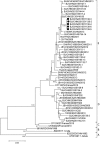An outbreak of Coxsackievirus A6-associated hand, foot, and mouth disease in a kindergarten in Beijing in 2015
- PMID: 30131060
- PMCID: PMC6103857
- DOI: 10.1186/s12887-018-1253-1
An outbreak of Coxsackievirus A6-associated hand, foot, and mouth disease in a kindergarten in Beijing in 2015
Abstract
Background: Coxsackievirus A6 (CVA6) is one of the major agents to cause hand, foot and mouth disease (HFMD) outbreaks globally. The objective of this study is to investigate the epidemiologic and clinical manifestations of CVA6 outbreak, and thus guide the diagnosis and treatment of the disease, as well as disease prevention.
Methods: An HFMD outbreak in a kindergarten was reported to Shijingshan District Center for Disease Control and Prevention (SCDC) on November 2, 2015 in Beijing, China. Epidemiological investigation was conducted. We performed a nine-week follow-up study to collect and analyze the clinical manifestations of HFMD cases.
Results: The outbreak yield 56 (15.7%) clinical diagnosed HFMD cases out of 357 registered children in the kindergarten with the mean age of 3.5 years old. This outbreak lasted for three days and ceased after initiating infectious disease controlling procedures, including periodical suspension of the kindergarten activities, environmental disinfection, and family health education. Fifty-one cases were followed for nine weeks. The positive rate of clinical manifestations of rash, fever, desquamation, pigmentation and onychomadesis were 100.0%, 84.3%, 68.6%, 17.6% and 43.1%, respectively. Children developed desquamation within the first 4 weeks after disease onset and developed onychomadesis between the 3th and 8th week after disease onset. Children with desquamation had 9.3 (95%CI: 1.836-47.437) times higher odds of developing onychomadesis compared to those without this manifestation. Ten out of 14 collected samples were CVA6 positive, and five positive samples shared a high degree of similarity in the VP1 nucleotide and amino acid sequences (99.9-100.0% and 100%).
Conclusion: This HFMD outbreak was caused by CVA6, featured with delayed symptoms. Emerging CVA6-associated HFMD and its delayed symptoms should be paid more attention to reduce outbreaks and provide more information to doctors and parents.
Keywords: Coxsackievirus A6; Disease outbreak; Hand foot and mouth disease; Onychomadesis.
Conflict of interest statement
Ethics approval and consent to participate
This study was in compliance with the Helsinki Declaration and was approved by the Human Research Ethics Committee of Beijing CDC. Written informed consent for sample collection in this study was received from the patient’s guardian.
Consent for publication
Not applicable.
Competing interests
The authors declare that they have no competing interests.
Publisher’s Note
Springer Nature remains neutral with regard to jurisdictional claims in published maps and institutional affiliations.
Figures
References
Publication types
MeSH terms
LinkOut - more resources
Full Text Sources
Other Literature Sources



